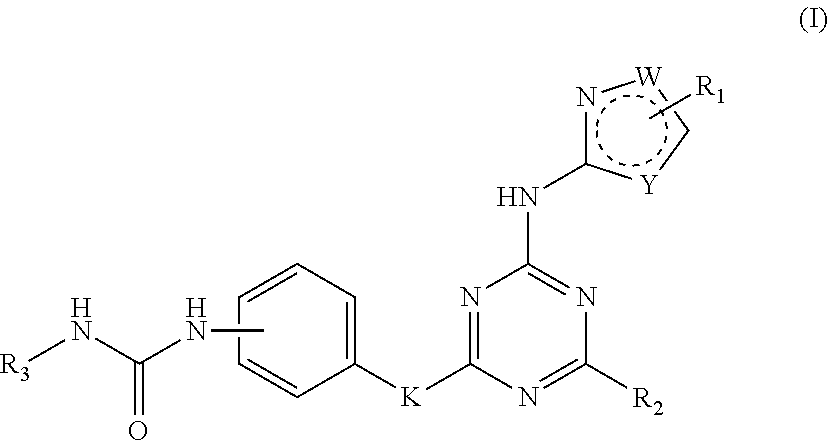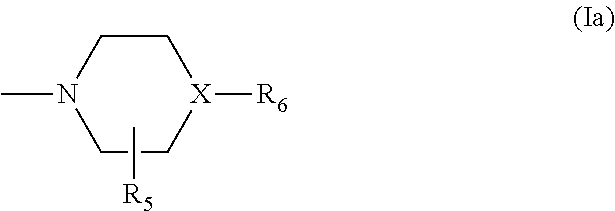Ureidophenyl substituted triazine derivatives and their therapeutical applications
a technology of ureidophenyl substituted triazine and triazine compounds, applied in the field of compounds, can solve the problems of chromosomal instability and aneuploidy, poor ability of mice without the lck gene to develop thymocytes, increased number of aneuploid cells, etc., and achieve the effect of blocking the activity of other receptors and enzymatic activity
- Summary
- Abstract
- Description
- Claims
- Application Information
AI Technical Summary
Benefits of technology
Problems solved by technology
Method used
Image
Examples
example 1
[0231]
[0232]A solution of 2-amino-5-methylthiazol (1.30 g, 13.56 mmol) and DIPEA (2.00 mL, 11.48 mmol) in THF (55 ml,) was added dropwise to a stirred solution of cyanuric chloride (2.50 g, 13.56 mmol) in THF (70 mL) at −5° C. After the addition was complete, the reaction mixture was stirred at −5° C. for 15 more minute. During the stirring, large amount of yellow precipitate formed, which was collected by filtration, washed with THF (3×20 mL), ethyl acetate (3×20 mL) and hexanes (1×10 mL). The compound 1 (2.72 g, 91%) was used directly for further reaction without purification.
example 2
[0233]
[0234]To a solution of compound 1 (565 mg, 2.16 mmol) in DMF (60 mL) was added a solution of 1-methylpiperazine (0.20 mL, 1.80 mmol) and DIPEA (0.35 mL, 1.80 mmol) in DMF (30 mL) dropwise at −15° C. After addition, the mixture was stirred at 0° C. for 30 minutes. A solution of 4-aminothiophenol (700 mg, 5.60 mmol) and sodium hydride (60%, 260 mg, 6.50 mmol) in DMF (7 mL) was added to the above reaction flak at room temperature. The mixture was stirred at room temperature for overnight. Saturated NH4Cl in water was added to the flask and the mixture was extracted by DCM / isopropal (v / v: 97 / 3, 3×). The combined organic was washed with water, dried over sodium sulfate and concentrated. The resulting crude product was purified by flash column chromatography on silica gel using methanol / DCM: 10 / 90 v / v as eluent to provide compound 2 as white solids (320 mg, 43%). 1H NMR (400 MHz, DMSO-d6) δ 11.20 (br, 1H), 7.14 (d, J=8.4 Hz, 2H), 7.00 (br, 1H), 6.60 (d, J=8.4 Hz, 2H), 5.60 (br, 2H),...
example 4
[0236]
[0237]To a solution of compound 2 (75 mg, 0.18 mmol) in DMM (5 mL) was added phenylisocyanate (0.05 mL, 0.45 mmol) and the mixture was stirred at room temperature for overnight. The mixture was concentrated to about 1 mL and DCM (15 mL) was added. After stirring overnight at room temperature, white solids precipitated, which were collected by filtration to provide compound 4 (65 mg, 68%). 1H NMR (400 MHz, DMSO-d6) δ 11.50 (s, 1H), 9.00 (s, 1H), 8.70 (s, 1H), 7.50-7.00 (m, 10H), 3.70 (m, 4H), 2.34 (m, 4H), 2.25 (br, 3H) 2.17 (s, 1H); ESI-MS: calcd for (C25H27N9OS2) 533, found 534 (MH+). HPLC: retention time: 21.643 min. purity: 97%.
PUM
| Property | Measurement | Unit |
|---|---|---|
| temperature | aaaaa | aaaaa |
| retention time | aaaaa | aaaaa |
| retention time | aaaaa | aaaaa |
Abstract
Description
Claims
Application Information
 Login to View More
Login to View More - R&D
- Intellectual Property
- Life Sciences
- Materials
- Tech Scout
- Unparalleled Data Quality
- Higher Quality Content
- 60% Fewer Hallucinations
Browse by: Latest US Patents, China's latest patents, Technical Efficacy Thesaurus, Application Domain, Technology Topic, Popular Technical Reports.
© 2025 PatSnap. All rights reserved.Legal|Privacy policy|Modern Slavery Act Transparency Statement|Sitemap|About US| Contact US: help@patsnap.com



